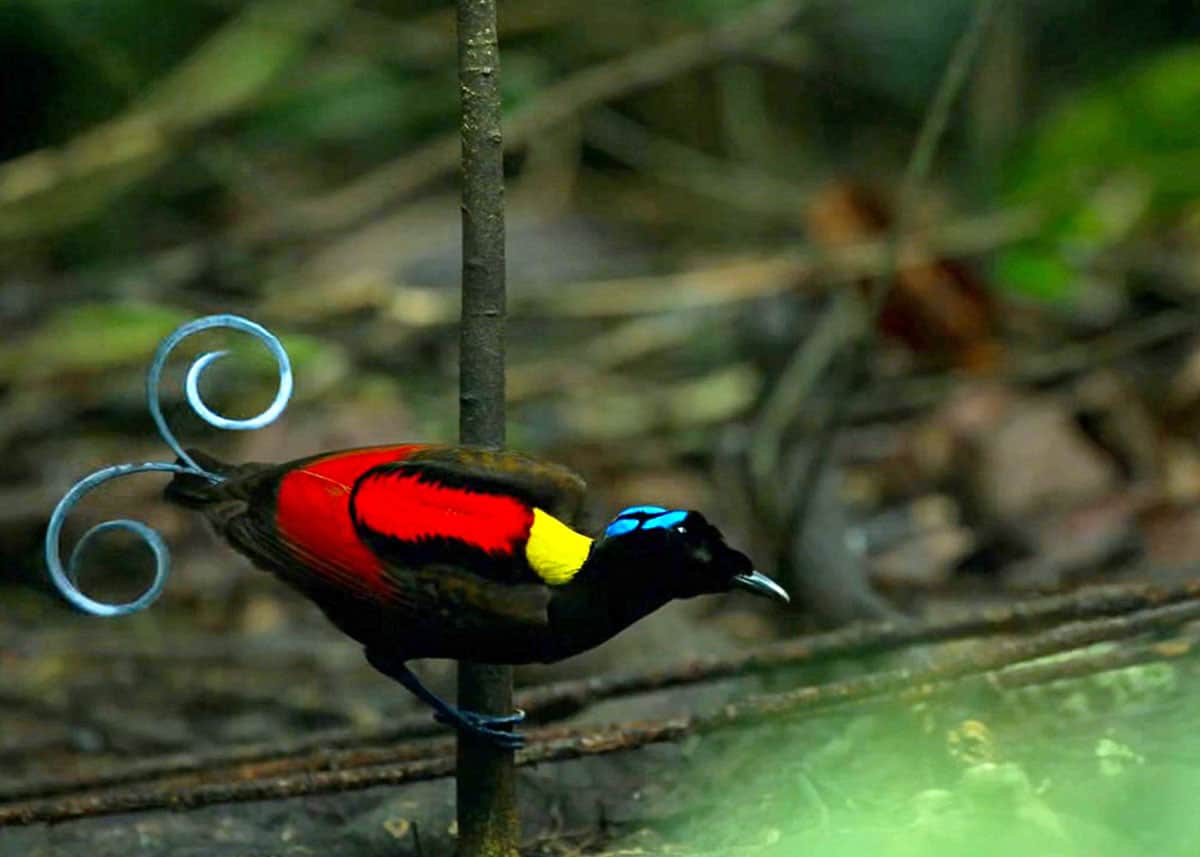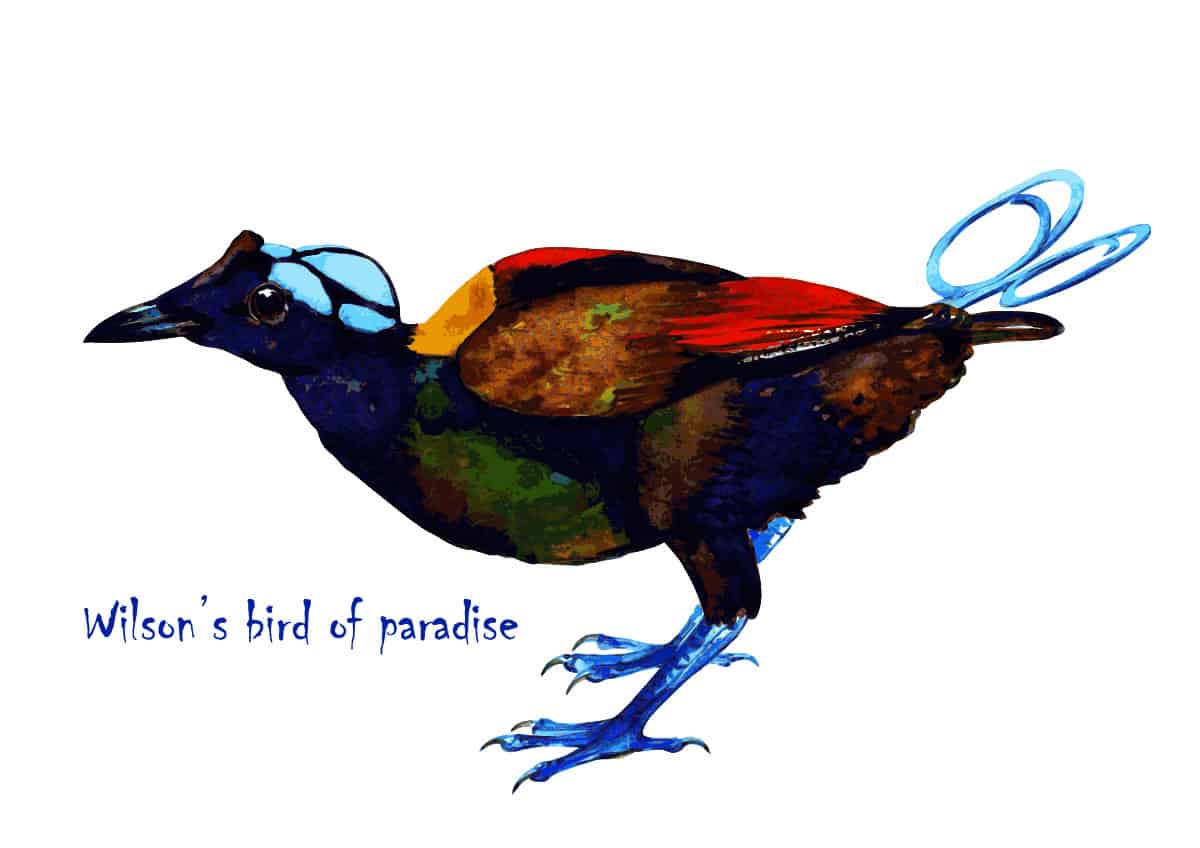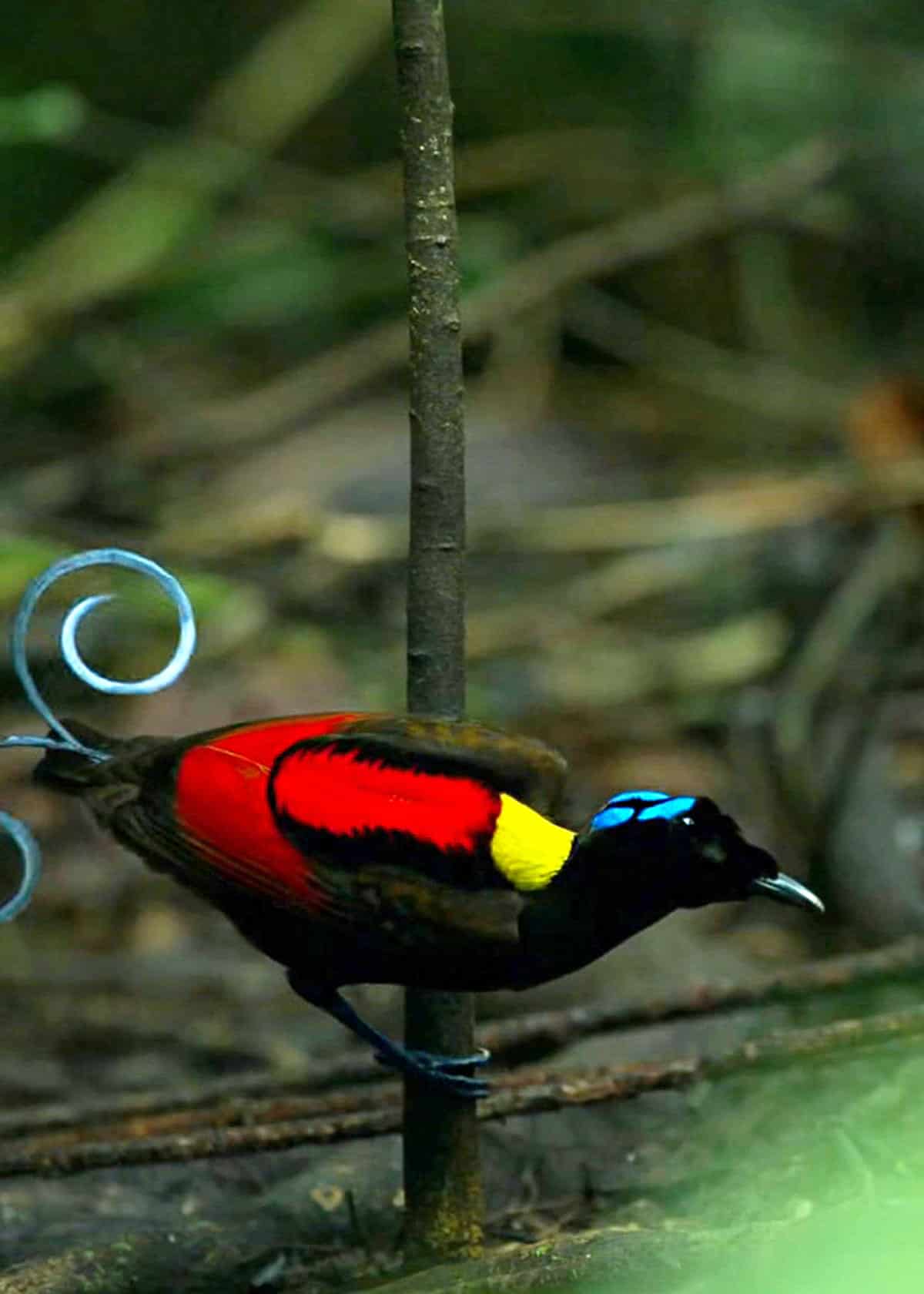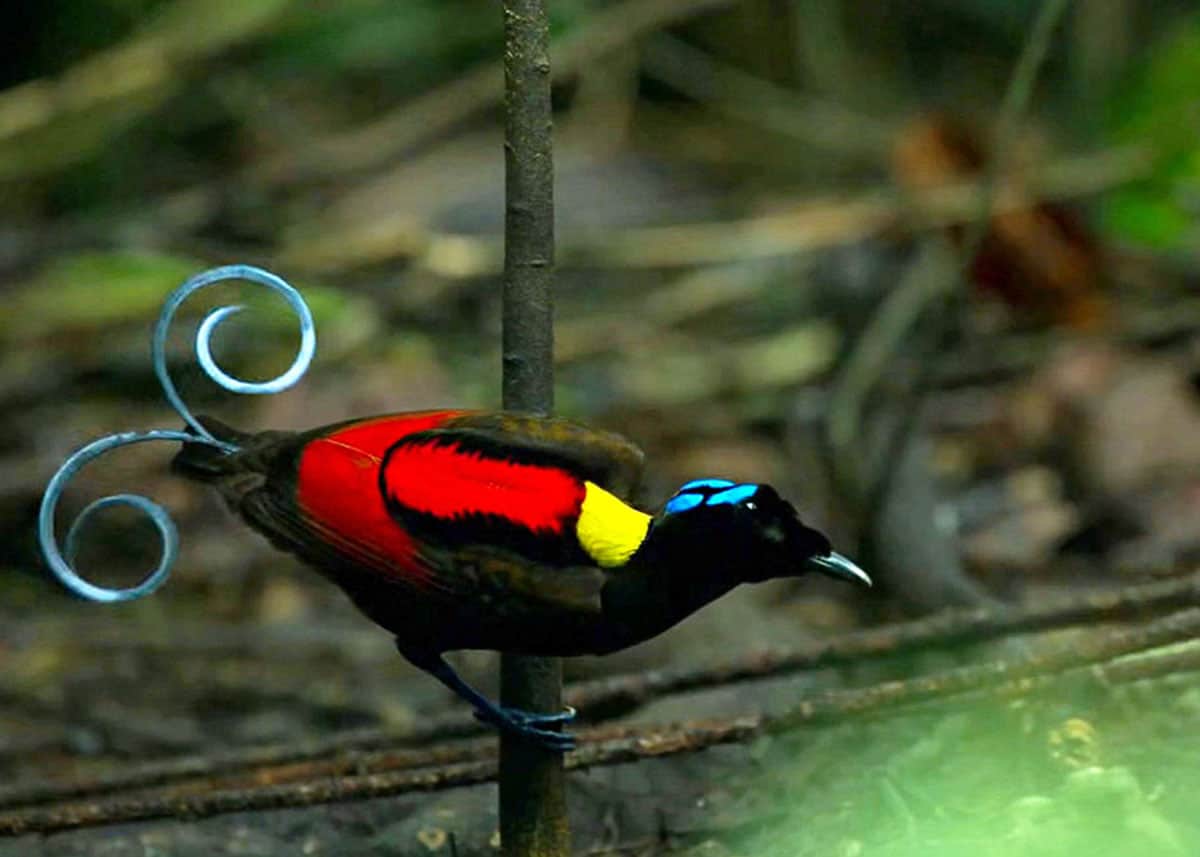Wilson’s bird of paradise is one of the most colorful birds in the world. In this post, you’ll learn 25 facts about Wilson’s bird of paradise, including appearance, habits, diet, and regions.

25 Wilson’s Bird of Paradise Facts: What You Need To Know
You probably won’t see a more fancy-looking bird than Wilson’s bird of paradise. Not only is it known for its bright colors and elaborate tail feathers, but its complex mating behavior will make you smile and shake your head at the same time.
As captivating as this bird is, there is far less information documented about it compared to other species.
But, don’t despair because we offer you the following 26 interesting Wilson’s bird of paradise facts.
1. What does Wilson’s bird of paradise look like?
There is no mistaking Wilson’s bird of paradise. You’ll know the male with one glimpse of his multicolored body and signature blue crown that resembles a bonnet.
The male’s back and wing tips are crimson while the upper wings and tail are brownish-black. He also sports a yellow cape, an emerald breast, violet legs and feet, and a pale green inner mouth.
His unique, turquoise crown (which is visible at night) is mostly bald with a few black feathers that create a criss-cross shape. Topping off his fancy suit are long, violet-blue tail feathers that split into two curlicues.
Watch on YouTube
Much less ornate than the adult male, the female and younger male are brown with a pale blue crown.
Don’t feel bad for the drab female because it is this sexual dimorphism that gives her the power to judge the male’s appearance and choose whether he will make a proper father for her offspring, genetically speaking.
2. How big is Wilson’s bird of paradise?
The Wilson’s bird of paradise averages about 6.3 inches (16 cm) in length.
Males can reach a length of 8.25 inches (21 cm) when including their curlicue tail feathers.
3. How much does Wilson’s bird of paradise weigh?
Adult males can weigh anywhere between 1.86 and 2.36 ounces (53 and 67 g) while adult females may weigh between 1.83 and 2.11 ounces (52 and 60 g).
4. What is Wilson’s bird of paradise’s wingspan?
It is estimated that Wilson’s bird of paradise wingspan is approximately 3 inches (7.62 cm).
5. How did the Wilson’s bird of paradise get its name?
You could say that Wilson’s bird of paradise got its name due to a political stance. During the mid-1800s, it was typical for zoologists to honor royal family members by naming newly discovered species after them.
But, when the British naturalist, Edward Wilson, purchased a specimen of a bird that was unknown at the time, Napoleon’s nephew, Charles Lucien Bonaparte, named it after Wilson. He did this because he was a dedicated republican and wanted to honor the commonwealth over royalty.
6. Are Wilson’s bird of paradises friendly? Or Aggressive?
Because of their limited range and solitary lifestyle, there is still much that experts don’t know about Wilson’s bird of paradise. So, maybe this species is just one of those types that are not necessarily unfriendly. They just prefer their own company.
Out of the whole bird of paradise family, Wilson’s species remains the most poorly known, so it’s difficult to say for sure whether they are aggressive or not.
However, multiple males have been observed displaying in the same area without any signs of being territorial.
7. How long do Wilson’s bird of paradises live?
Wilson’s birds of paradise have a lifespan of 5 to 8 years in the wild but can live up to 30 years in captivity.
8. What eats a Wilson’s bird of paradise? Predators and Threats
Snakes, hawks, owls, and humans are some of the known predators of this bird of paradise.
Other threats and factors that may decrease the population of this species include humans hunting for their feathers and habitat loss due to forest fires and logging.
9. Is the Wilson’s bird of paradise endangered?
The Wilson’s bird of paradise is not endangered, but due to its confined range and habitat loss, the IUCN Red List of Threatened Species ranks this species as “Near Threatened.”
10. What do Wilson’s bird of paradises eat?
The Wilson’s bird of paradise is an omnivore, feeding on both plants and animals.
They enjoy eating a balanced diet of fruits and some small insects.
11. What is the Wilson’s bird of paradises Latin name?
The Latin name for the Wilson’s bird of paradise is Diphyllodes respublica.
12. What other names does the Wilson’s bird of paradise have?
The Malay people of Indonesia call this species the “birds of the gods.”
13. Do Wilson’s bird of paradises mate for life?
No, Wilson’s birds of paradise do not mate for life. The males are polygynous, meaning that they mate with multiple females at a time.
After mating, the female will go about her business of building a nest while the male heads back to his mating dance arena to attract a new female.
14. What is Wilson’s bird of paradise mating dance?
Even though this bird hasn’t been studied as in-depth as other species, we do know some interesting Wilson’s bird of paradise facts regarding courtship rituals.
Thanks to experts like the British naturalist, David Attenborough, who first filmed this bird’s mating dance in 1996, we know that this bird is obsessed with cleaning his arena before inviting a female over to his place.
The male Wilson’s bird of paradise is meticulous about sweeping his “dance floor” clean of leaves and other debris. After he is satisfied with how his court looks, he will then set out to attract a female.
But, his first step is taking on a peculiar frozen posture while perched on a vertical branch. Once a female acknowledges him, he will then begin to vocalize with her while showing off his bright colors and gaping at her with his inner mouth.
As the ritual intensifies, he will also display his throat feathers that expand into a wide disc around his neck and face.
15. At what age do Wilson’s bird of paradise lay eggs?
Females of this species begin laying eggs when they become sexually mature which is believed to between 2 and 3 years of age.
16. How often do Wilson’s bird of paradises lay eggs?
Information on Wilson’s bird of paradise facts regarding eggs is unavailable, but these bird species mate twice a year (May/June and October).
17. How many eggs does Wilson’s bird of paradise lay? What do they look like?
It is not known for sure about this species, but based on other bird of paradise species of the same size, it is believed that the female Wilson’s bird of paradise lays between 1 and 3 eggs per clutch and that they are tan or brown with dark spots.
18. What is Wilson’s bird of paradises call?
If you have ever heard a car alarm going off, then you know what the call of Wilson’s bird of paradise sounds like.
But, in case you live in some remote area and have never heard a car alarm, this bird’s call is loud shrill that is repeated several times.
Watch on YouTube
19. Are Wilson’s bird of paradises loud?
The Wilson’s bird of paradise is not known to be a noisy bird but does make himself heard in the forest.
As stated above, this bird’s call sounds like a car alarm going off, and even though it can be heard several feet away, it is not nearly as ear-piercing as a car alarm.
20. Do Wilson’s bird of paradises carry disease?
While many bird species can carry parasites and diseases such as avian influenza (bird flu) and avian malaria, there is no current information on any Wilson’s bird of paradise diseases.
Researchers do occasionally take blood samples of various birds on the islands where these birds of paradise live, but there aren’t any readily available reports of any diseased Wilson’s birds of paradise on the Internet.
21. Where does Wilson’s bird of paradise live?
The Wilson’s bird of paradise lives only on the islands of Batanta and Waigeo which are located off the northern coast of West Papua, Indonesia.
22. What is the habitat of Wilson’s bird of paradise?
While this bird of paradise prefers the tropical hill forests and moss forests at elevations of around 1,000 feet (300 m), it has also been observed in lowland rainforests and higher mountain forests.
23. Where do Wilson’s bird of paradises nest?
It is the female Wilson bird of paradise that solely takes care of all the nesting duties, and she usually builds her nest in the fork of a tree from materials such as leaves, vines, and ferns.
24. Where can I see the Wilson’s bird of paradise?
The Wilson’s bird of paradise is an elusive bird that mostly stays to itself outside of the breeding season, so it may be challenging to see it in the wild.
Arranging a birding tour in Indonesia with a skilled guide may increase your chances of seeing it. Otherwise, some people have claimed to have seen this species at the Jurong Bird Park in Jurong, Singapore.
25. How many birds of paradise are there?
Depending on you ask, there are anywhere between 39 and 45 types of birds of paradise. In addition to Wilson’s bird of paradise, here are 40 of them:
- King bird of paradise
- Greater bird of paradise
- Red bird of paradise (Near Threatened)
- Lesser bird of paradise
- Blue bird of paradise (Vulnerable)
- Victoria’s riflebird
- Superb bird of paradise
- Wahnes parotia (Near Threatened)
- Twelve-wired bird of paradise
- Ribbon-tailed astrapia (Near Threatened)
- King of Saxony bird of paradise
- Magnificent riflebird
- Paradise riflebird
- Western parotia
- Raggiana bird of paradise
- Black-billed Sicklebill
- Stephanie’s astrapia
- Long-tailed paradigalla (Near Threatened)
- Pale-billed sicklebill (Near Threatened)
- Emperor bird of paradise (Near Threatened)
- Wallace’s Standardwing
- Halmahera paradise-crow
- Obi Paradise-crow
- Trumpet manucode
- Glossy-mantled manucode
- Jobi manucode
- Crinkle-collared manucode
- Curl-crested manucode
- Carola’s parotia
- Bronze parotia
- Lawes’s parotia
- Standardwing bird of paradise
- Growling riflebird
- Black sicklebill
- Brown sicklebill
- Short-tailed paradigalla
- Arfak astrapia
- Splendid astrapia
- Huon astrapia
- Goldie’s bird of paradise (Vulnerable)
Your Turn
We hope you have enjoyed reading these Wilson’s bird of paradise facts. Are you as impressed with this little bird as much as we are?
If you have any questions (or answers) that are not included in this post, please be sure to let us know in the comments.
Drew Haines is an animal enthusiast and travel writer. She loves to share her passion through her writing.
She graduated high school at sixteen and started her own business, Everywhere Wild Media. And she runs Everywhere Wild and JustBirding. She also guest blogs on Storyteller.Travel
She lived in Ecuador for 6 years and explored the Galapagos Islands. Currently based in N.S., Canada.



